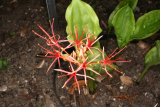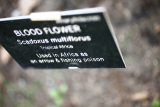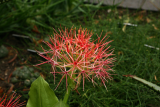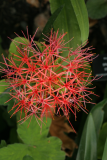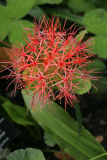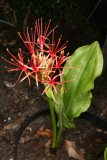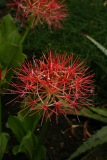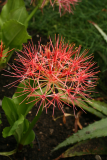Additional notes (click to expand)
Horticulture
Native to Eastern Africa and producing a large head of scarlet red flowers. This bulb is ideal for a cool greenhouse. Plant as soon as possible in well-crocked 15cm pot with the top surface of the bulb exposed. The compost should be loam based with additional coarse sand and peat or leaf mould mixed in. Water very sparingly until growth appears and then gradually increase the amount, taking care not to over water. After flowering continue watering until the foliage starts to go yellow, gradually reducing the amount given as the bulb start to go dormant. At the time the pit may be placed on its side in the frost-free place with the bulb enjoying a rest prior to bring restarted into growth in the spring. Height 40-60cm. Frost tender, minimum temp. 10C.
Information from Jacques Amand International (June 2018)
Medicinal
The bulb is used to treat oedema, scabies and poorly healing wounds.
In South Africa, Scadoxus puniceus appears to be more commonly used, to treat coughs and gastro-intestinal problems and forms part of a medicine taken during pregnancy to ensure safe delivery.
[but note it is very toxic - see Toxicity]
PlantzAfrica.com. South African National Biodiversity Institute, South Africa. www.plantzafrica.com
Galanthamine is found in this plant. Used to reverse non-depolarising muscle relaxants such as curare. Inhibits reversible cholinesterases in both central and peripheral nervous system. Blocks cholinesterase at neuromuscular junction and parasympathtic nerve endings.
For detailed pharmacology, see the reference.
Neuwinger, HD. (1996). African Ethnobotany: Poisons & Drugs, Chapman & Hall page 24
Nomenclature
Scadoxus multiflorus Raf. Amaryllidaceae. Blood Flower, Poison root, Fireball Lily. Distribution: Sub-Saharan Africa. The genus name is a concatenation of the Greek words, Sciadion meaning a parasol or umbel, and doxa meaning 'glorious'; multiflorus is Latin for 'many flowers' (Stearn, 1994).
Oakeley, Dr. Henry F. (2013). Wellcome Library notes.
link
Other use
Scadoxus multiflorus Raf. Amaryllidaceae. Blood Flower, Poison root, Fireball Lily. Distribution: Sub-Saharan Africa. The genus name is a concatenation of the Greek words, Sciadion meaning a parasol or umbel, and doxa meaning 'glorious'; multiflorus is Latin for 'many flowers' (Stearn, 1994). The juice of the bulbs is an ingredient of arrow poisons in several countries; in Guinea and Nigeria it is used as a fishing poison. 25 gm of leaf or bulb is sufficient to kill a sheep or a goat, and the leaves are just as toxic as the bulbs. It is used in Senegal for heart failure, and elsewhere for wounds, a lubricant for cows at parturition, scabies and (in India) for colds and asthma. It contains numerous alkaloids including galanthamine. This has antiacetylcholinesterase activity and has been proposed as being useful in Alzheimer’s syndrome. It also reverses the effects of curare. The effects of all the alkaloids have been studied and are numerous. See Neuwinger (1996).
Oakeley, Dr. Henry F. (2013). Wellcome Library notes.
link
Phytochemistry
Contains numerous alkaloids - lycorine, haemanthidine, chlidanthine, hippeastrine, montanine, pratorimine, narciclasine, haemanthamine, kalbretorine, kalbreclasine, pancratistatine, pancratiside, and galanthamine.
Neuwinger, HD. (1996). African Ethnobotany: Poisons & Drugs, Chapman & Hall page 21-25
Toxicity
Used in Cameroon, Gabon, Angola and the Central African Republic with other plants, as an arrow poison. In Guinea and N. Nigeria bulbs used as fishing poison.
PlantzAfrica.com. South African National Biodiversity Institute, South Africa.
Powdered dry root used for murder. Used as an arrow and fishing poison. Livestock which eat the leaves or bulbs, die (even quantities as low as 25gm) with epicardial and endocardial haemorrhages, and heamorrhagic liver and kidneys.
Neuwinger, HD. (1996). African Ethnobotany: Poisons & Drugs, Chapman & Hall page 22-25
'Humans/Pets: Ornamental bulbs, not to be eaten.' HTA guidelines.
HTA Guide to Potentially Harmful Plants, 3rd Edition (2022)
Geographical distribution
- Africa
Scadoxus multiflorus (Martyn) Raf.
Family: AMARYLLIDACEAEGenus: Scadoxus
Species: multiflorus (Martyn) Raf.
Common names: Blood Flower
Distribution summary: Tropical Africa
Habit: Bulbous
Hardiness: H1b - Heated greenhouse; subtropical
Habitat: lowland to mountain forests, forest margins, savannah woodland, open grassland, shady river banks
Garden status: Currently grown
Garden location: Plants in pots (POT), Arid zones (Q)
Reason for growing: Medicinal, toxic
.JPG)
